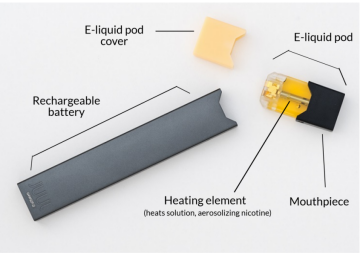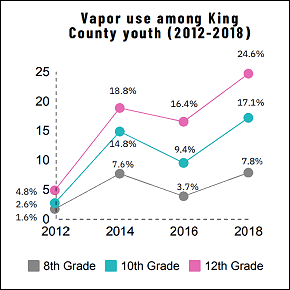
Severe lung disease associated with using vaping devices and e-cigarette products
Background photo created by freepik - www.freepik.com
Public Health — Seattle & King County is closely monitoring the ongoing investigation of the severe lung disease associated with using vaping devices and e-cigarette products.
Select a tab below to reveal information:
Frequently Asked Questions about vaping and the lung illness outbreak also available in PDF format.
Across the United States, there have been reports of severe lung illnesses and deaths associated with vaping and e-cigarette use. The specific cause of the illness is not known. There have been over one thousand confirmed cases throughout the U.S., including several in Washington state.

- nicotine
- tetrahydrocannabinol (THC, the psychoactive component in cannabis/marijuana)
- cannabidiol (CBD, another chemical found in cannabis/marijuana)
- flavorings and other additives like heavy metals and oils
- E-cigarettes and vaping are not safe. Avoid using e-cigarettes and vaping until the cause of this outbreak is known.
- Talk to your kids about the risks of vaping.
- Seek medical attention if you experience coughing, shortness of breath, chest pain, nausea or fatigue and use e-cigarette products.
- Do not buy e-cigarette products off the street or modify them.
- Youth, young adults, pregnant women, and adults who do not currently use tobacco products should not use e-cigarettes.
We do not know yet what causes this illness. Many, but not all, patients who developed this illness report that, in addition to nicotine, they vaped pre-filled cartridges of cannabis-derivative products like THC or CBD.
We do not know yet. Testing at several national labs has identified a compound – Vitamin E acetate – in some, but not all, of the THC product samples collected from people who became sick. However, we do not know if Vitamin E acetate was the cause, or even one of several causes, of the illness. There is also no way for you to test if a product you purchase contains Vitamin E acetate or any other possibly harmful chemical.
FAQs in other languages (more languages will be added when made available):

- 1 in 4 high school seniors report vaping in the past 30 days.
- 10th grade use increased by 82% between 2016 and 2018
- Nicotine is the most common substance used when vaping
- Lesbian, Gay, and Bisexual (LGB) youth have significantly higher rates of vapor use rates than heterosexual youth
- Pod-based units like JUUL are popular among youth. They contain extremely high levels of nicotine. 1 JUUL pod = ~20 cigarettes in terms of nicotine.
- E-cigarette and vapor products are attractive to kids and teens in part due to the variety of sweet, candy-like flavors.
- Besides nicotine, nearly all e-cigarette products have toxic substances including heavy metals.
- Kids are especially vulnerable to the harmful and addictive effects of nicotine. Early nicotine addiction can harm brain development and cause problems with attention, memory and impulse control and potentially increase the risk for addiction to other substances.
Translations in other languages (more languages will be added when made available):
KING COUNTY RESPONSE
- Media briefing on vaping illness in Washington, Facebook
- Executive Constantine on urgent action needed to address youth vaping
STATE AND NATIONAL RESPONSE
For providers
- Report patients hospitalized with severe pulmonary disease of unclear etiology and a history of e-cigarette or vaping product use within the past 90 days to Public Health at 206-296-4774.
- Updated CDC information for health care providers
For partners
For schools
Visit the Public Health Insider blog for more articles on
tobacco and vapor prevention
CONTACT US
Tobacco Prevention Program
401 5th Ave, Ste. 1110,
Seattle, WA 98104
206-263-8271
tobacco.prevention@kingcounty.gov
Use our online form
Link/share our site at
www.kingcounty.gov/vape

 Translate
Translate